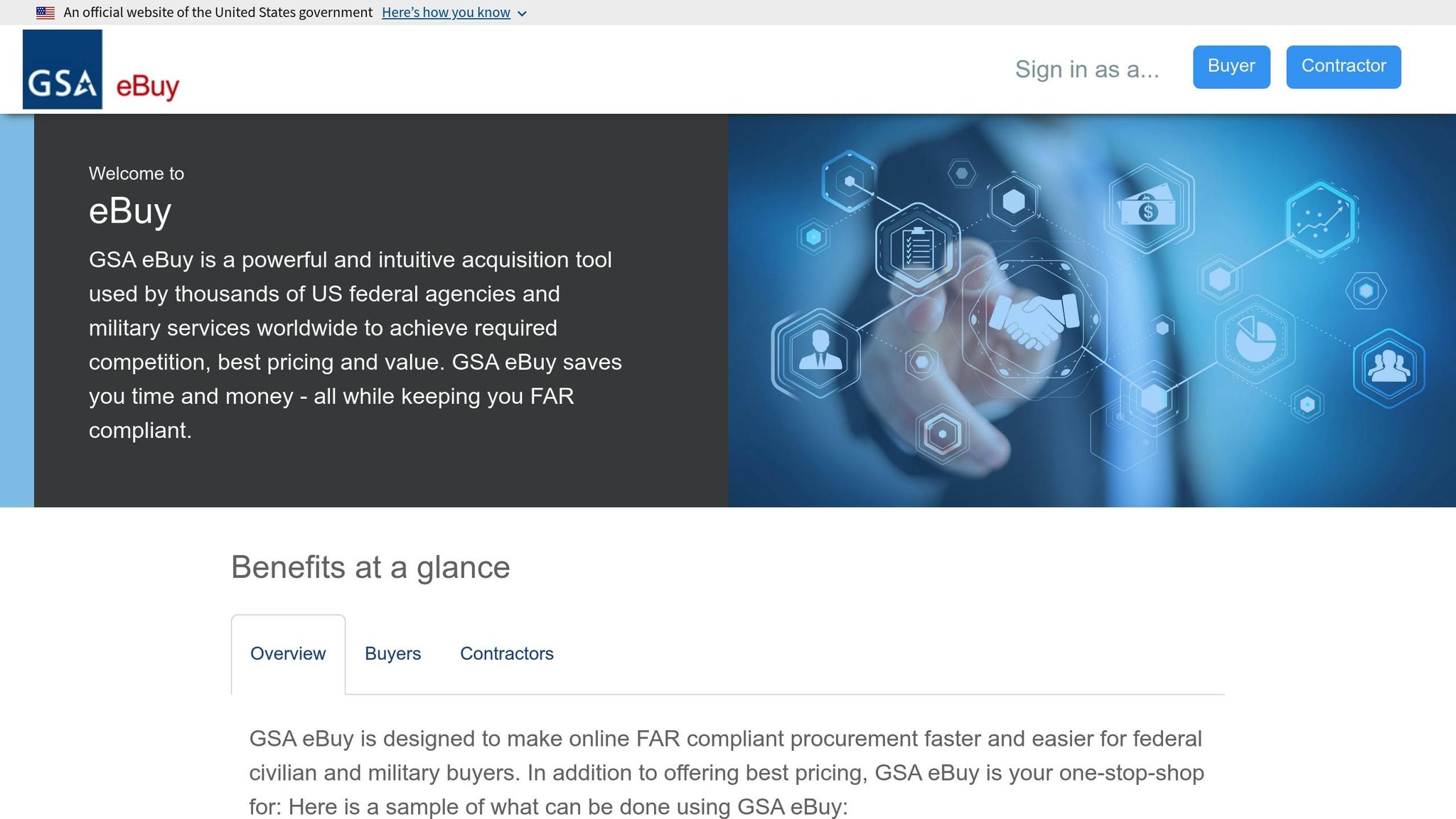If you’re a small business looking to secure federal contracts, GSA eBuy can connect you to billions of dollars in government opportunities. Here’s what you need to know:
- What is GSA eBuy? It’s an online platform where government agencies post procurement needs, and vendors with GSA Schedule contracts can submit bids.
- Why use it? Over 17,000 agencies post more than 1.2 million opportunities annually, valued at $55 billion. Small businesses can compete for set-asides like 8(a), WOSB, and HUBZone.
- How it works: Agencies post RFQs/RFPs, vendors get notified of relevant opportunities, and bids are submitted through a secure system.
- Who can use it? Only vendors with active GSA Schedule contracts can participate. State and local governments also use GSA eBuy for specific programs.
Quick Tip: To get started, secure a GSA Schedule contract, set up your GSA Advantage profile, and monitor the platform daily for opportunities that match your offerings.
Keep reading to learn how to maximize your chances of winning contracts through GSA eBuy!
GSA eBuy Tutorial (2022)

What is GSA eBuy?
GSA eBuy is an online tool designed to connect government buyers with vendors holding GSA Schedule contracts. Acting as a specialized marketplace, it allows federal agencies to post their procurement needs while enabling qualified contractors to submit detailed quotations for those opportunities.
While GSA eBuy is part of the broader GSA Advantage platform, it caters to more complex procurements. GSA Advantage is ideal for simple catalog purchases, but eBuy focuses on larger contracts that often require competitive bidding and in-depth proposals. Through this platform, government buyers can request quotes for a wide range of commercial products and services, using acquisition methods like GSA and VA Multiple Award Schedules, Governmentwide Acquisition Contracts (GWACs), Blanket Purchase Agreements (BPAs), and Federal Strategic Sourcing Initiative contracts.
How the Platform Works
GSA eBuy operates with a straightforward and efficient model. Government buyers post RFQs (Requests for Quotes), RFPs (Requests for Proposals), and other solicitations directly on the platform. Vendors with active GSA Schedule contracts receive automated notifications for opportunities matching their offerings. Buyers can refine their searches by Special Item Number (SIN) or socio-economic criteria, ensuring they engage vendors who meet their specific needs. Once a solicitation is live, qualified vendors are promptly notified, allowing them to respond without delay.
To maintain fairness, the platform ensures that only the issuing government buyer can view submitted proposals. This confidentiality fosters a competitive environment where vendors focus solely on presenting their best offers.
GSA eBuy isn’t just for federal agencies. State and local governments can also participate, although their use is limited to programs like the Cooperative Purchasing Program and the Disaster Recovery Purchasing Program. This expanded access broadens the range of opportunities for vendors, while the competitive setup encourages buyers to solicit bids from multiple vendors, awarding contracts based on the best value for taxpayers.
Benefits for Small Businesses
For small businesses, GSA eBuy offers several key advantages that make it easier to compete in the government contracting space.
The platform levels the playing field by automatically notifying small businesses about relevant opportunities. This eliminates the need for extensive outreach or cold calling, allowing these businesses to focus their efforts on crafting strong proposals. The transparent and competitive nature of the platform ensures that every vendor has an equal chance to win contracts.
Speed is another major benefit. By enabling buyers to solicit multiple vendors quickly, GSA eBuy shortens the time between identifying an opportunity and awarding a contract. This efficiency can be especially valuable for small businesses by helping improve cash flow and reducing the wait for new work.
Perhaps most importantly, GSA eBuy opens the door for small businesses to compete for high-value contracts that were previously dominated by larger firms. The platform provides access to specialized, lucrative opportunities, empowering small businesses to grow and expand their reach.
The scale of GSA eBuy underscores its impact: over 17,000 federal, state, and local agencies use the platform, posting more than 1.2 million RFQs and RFPs annually. These opportunities amount to over $55 billion each year. For small businesses, this represents a game-changing chance to access contracts that were once out of reach, all through a streamlined and accessible digital marketplace.
Who Can Use GSA eBuy?
GSA eBuy operates with strict eligibility criteria to ensure a competitive and efficient procurement process for both vendors and government buyers. Meeting these requirements is essential for anyone looking to participate on the platform.
Requirements for Vendors
If you’re a business hoping to sell on GSA eBuy, there’s one non-negotiable rule: you must have an active GSA Multiple Award Schedule (MAS) contract. Without it, gaining access to the platform or submitting bids isn’t possible.
GSA Schedules are long-term contracts that allow government agencies to purchase commercial products and services at pre-negotiated prices. These contracts form the backbone of every transaction on GSA eBuy. To get started, vendors need to register their MAS contract through the Vendor Support Center (VSC) and upload their catalog to GSA Advantage!, creating a digital storefront that links directly to the eBuy platform.
Securing a GSA Schedule contract isn’t a quick process – it can take several months. However, the effort is worth it. Federal agencies spend over $600 billion annually on goods and services, and having a GSA Schedule contract positions vendors to tap into this massive market.
"GSA eBuy is one of the most powerful tools for vendors with a GSA Schedule contract to connect with government buyers." – Greenwood Aerospace
For businesses without a GSA Schedule contract, the path forward is clear: apply for and secure a GSA Schedule contract first. This step is essential and cannot be replaced by other certifications or shortcuts.
Just as vendors must meet specific requirements, government buyers also follow defined processes to make the most of GSA eBuy.
How Government Buyers Use the Platform
On the buyer side, GSA eBuy provides a streamlined and intuitive interface for federal, state, and local agencies to meet their procurement needs. However, access levels differ based on the type of agency.
- Federal agencies: They can post RFQs for supplies and services across all acquisition solutions available on eBuy.
- State and local agencies: Their access is more limited, restricted to posting RFQs under the Cooperative Purchasing Program and the Disaster Recovery Purchasing Program.
To use GSA eBuy, government buyers must first register on GSA Advantage, using the same User ID and password for both platforms. This unified login system simplifies access while maintaining security.
The platform offers advanced search and filtering tools, making it easier for buyers to find exactly what they need. For example, buyers can filter vendors by SINs (Special Item Numbers) or socio-economic categories, such as small business classifications. They can also set aside orders specifically for small businesses, supporting federal contracting goals.
One of the biggest advantages for buyers is the platform’s ability to connect them with a wide network of suppliers, often leading to competitive pricing and potential cost savings. The scale of activity is impressive: over 1.2 million RFQs and RFPs are posted annually, with opportunities exceeding $55 billion in value each year.
From posting RFQs to awarding contracts, GSA eBuy offers comprehensive tools to manage the entire procurement process. This makes it an indispensable resource for government agencies looking to streamline their purchasing activities.
sbb-itb-8737801
How to Find and Respond to Opportunities
Once you’re on GSA eBuy, the next step is to identify the right opportunities and craft competitive bids. With the platform hosting a vast number of RFQs and RFPs, knowing how to navigate efficiently is critical for securing contracts that align with your business.
Finding the Right Opportunities
The key to success on GSA eBuy is strategic searching. Instead of browsing through every listing, use filters like SINs, NAICS, and PSC codes to zero in on opportunities that match your offerings.
Try combining product or service keywords with NAICS and PSC codes for more targeted results. Keep an eye on recurring keywords in opportunity titles – they can guide you in refining future searches and expanding your reach.
You can also filter opportunities by industry, buyer agency, or contract type. If your business qualifies as a small business, create saved searches for set-asides like 8(a), Women-Owned Small Business (WOSB), or HUBZone programs. At the same time, maintain a general saved search without set-aside filters to avoid missing broader opportunities.
Rather than trying to appeal to every agency, focus your efforts on a few key government customers. Building strong relationships with these agencies can often yield better results than spreading your efforts too thin.
Once you’ve identified promising opportunities, take the time to thoroughly review the solicitation documents.
Reading Solicitation Documents
Carefully go through all solicitation documents to fully understand the requirements and evaluation criteria. Pay attention to the type of requirements document provided – it could be a Statement of Work (SOW), Performance Work Statement (PWS), or Statement of Objectives (SOO). Each format requires a different approach in your response and determines the level of detail you’ll need to include.
Sign up for notifications to stay updated on any changes to the solicitation. Amendments or newly added information can be crucial to shaping your proposal. Be sure to download all attachments to capture essential details like technical specifications, delivery requirements, and evaluation criteria.
How to Submit Your Bid
After a detailed review of the solicitation, it’s time to prepare your bid. GSA eBuy introduced the "Interested" feature in 2022, which allows you to express preliminary interest. This can help establish early communication with the contracting officer before you submit a full proposal.
When crafting your submission, remember that proposals and quotes are confidential, visible only to the government buyer. Tailor your response to address the specific needs outlined in the solicitation and ensure your pricing is competitive to boost your chances of success.
Double-check that your GSA Advantage! catalog and pricing are up to date. Outdated information can raise concerns for buyers. Keep a close eye on RFQ deadlines and aim to submit your quotes early – not only does this increase your chances of consideration, but it also gives you a buffer in case of technical issues.
Follow the RFQ instructions to the letter. This includes meeting all formatting requirements, adhering to pricing guidelines, and including all necessary documents. Finally, review your submission thoroughly for accuracy and completeness – small errors can undermine even the most competitive bids.
Tips for New Users
Getting started with GSA eBuy can feel like a daunting task, but a little preparation and organization can make a world of difference. Avoiding common mistakes early on will set you up for better results and smoother navigation of the platform.
Managing Deadlines and Staying Organized
Staying on top of deadlines is critical when using GSA eBuy. Many solicitations are time-sensitive, and opportunities can disappear quickly. To stay ahead, assign someone in your organization as the go-to person for checking the platform daily. This ensures you never miss an important opportunity. When submitting bids, aim to do so at least 24 hours before the deadline. This cushion gives you time to address any technical hiccups, and if delays arise, notify the Contracting Officer right away.
Take advantage of the platform’s built-in tools to simplify your workflow. The "Save Draft" feature allows you to save your progress and return to it later, while the "My RFQs" section helps you manage both active and archived opportunities. Setting up a dependable system to track RFQ deadlines will ensure you never miss a chance to compete for valuable contracts.
Once your deadlines are under control, focus on leveraging resources to tackle compliance and technical challenges.
Seeking Help When Needed
Compliance issues can trip up new users, but GSA eBuy provides resources to help you navigate these challenges. Common pitfalls include offering non-compliant products, misrepresenting items, or failing to address equivalency requirements. To avoid these errors, double-check that your products meet the Trade Agreements Act (TAA) standards and confirm that manufacturers are listed in the Verified Products Portal before adding items to your GSA Schedule.
It’s also essential to keep accurate records for Transactional Data Reporting and ensure timely payment of the Industrial Funding Fee to fulfill your contract obligations. Remember, securing your GSA Schedule is just the starting point. To maintain momentum, develop a post-award marketing plan that includes registering on GSA Advantage, updating your Vendor Support Center profile, and actively monitoring eBuy for fresh opportunities.
Once you’ve mastered compliance and organization, it’s time to focus on crafting winning proposals.
Writing Proposals That Stand Out
A well-crafted proposal can set you apart, especially when competition is limited. Over 50% of government contracts receive only 1-3 bids, so a thoughtful and detailed submission can make all the difference. Start by thoroughly reviewing the Statement of Work (SOW) and creating a compliance matrix that maps out how your proposal meets each requirement. This approach ensures your response is tailored to the agency’s needs, rather than sounding generic.
Key elements of your proposal should align with the type of solicitation:
| Element | Importance in RFQ | Importance in RFP |
|---|---|---|
| Cost Breakdown | High | Moderate |
| Technical Specification | Moderate | High |
| Delivery Timelines | High | High |
| Past Performance | Low | High |
| Innovativeness | Low | Moderate |
Use a structured review process to identify and address any gaps in your proposal. Beyond the document itself, focus on building strong relationships with government buyers, pricing your products competitively, and maintaining the high standards of quality and compliance that justify your pricing. These strategies will not only boost your chances of winning but also help you establish a solid reputation in the marketplace.
Conclusion: Getting Started with GSA eBuy
To dive into GSA eBuy, the first thing you’ll need is an account on GSA Advantage, as both platforms are interconnected and share account details. Once your account is active, you’ll be ready to browse and explore a range of federal contracting opportunities. Don’t wait – get started today and open the door to valuable federal business prospects!
FAQs
How can a small business get a GSA Schedule contract and start using GSA eBuy?
To begin, small businesses should register on SAM.gov to get a Unique Entity ID (UEI) and complete their entity registration. Next, identify the appropriate NAICS codes for your business and confirm your small business status through the SBA.
Once your registration is complete, gather key documents such as pricing templates, references showcasing past performance, and financial statements. Then, submit your proposal via eOffer. Keep in mind that the approval process usually takes 3–6 months, so it’s important to factor this timeline into your planning.
After obtaining your GSA Schedule contract, you’ll gain access to GSA eBuy, a platform where you can explore federal opportunities, submit bids, and compete for government contracts. This tool can help you expand your business and establish steady sales in the federal marketplace.
How can small businesses improve their chances of winning contracts on GSA eBuy?
To boost your success rate on GSA eBuy, start by diving into the needs of your target agencies. Make sure your offerings align perfectly with what they’re looking for. Keep a close eye on the Requests for Quotes (RFQs) posted on the platform, and when you respond, craft proposals that clearly show how your solutions address their specific requirements.
Digging into market research can also give you an edge. Learn who the key decision-makers are and pay attention to trends in agency purchasing habits. Beyond the formal RFQs, take the time to build relationships through networking or outreach efforts – these connections can lead to future opportunities. And don’t overlook the basics: keep your GSA Schedule current and make sure it’s marketed effectively to catch the attention of buyers searching for your products or services.
What challenges do vendors face on GSA eBuy, and how can they address them?
Vendors using GSA eBuy often encounter challenges like managing the intricate proposal process, choosing the right Special Item Numbers (SINs), and adhering to strict federal procurement regulations. For newcomers, these tasks can seem especially daunting.
To tackle these obstacles, it’s important to start by thoroughly reviewing GSA’s official guidelines. Take advantage of available resources, such as training modules and detailed step-by-step guides, to better understand the process. Before submitting, ensure your proposals are accurate and complete – small errors can lead to setbacks. Additionally, keeping up with updates to GSA policies and familiarizing yourself with best practices can boost your chances of success while helping you avoid common missteps.
Related posts
- How to Access GSA Small Business Support Programs
- Types of Federal Procurement Methods Explained
- How GSA Advantage Simplifies Federal Buying
- How GSA Evaluates Bid Opportunities


